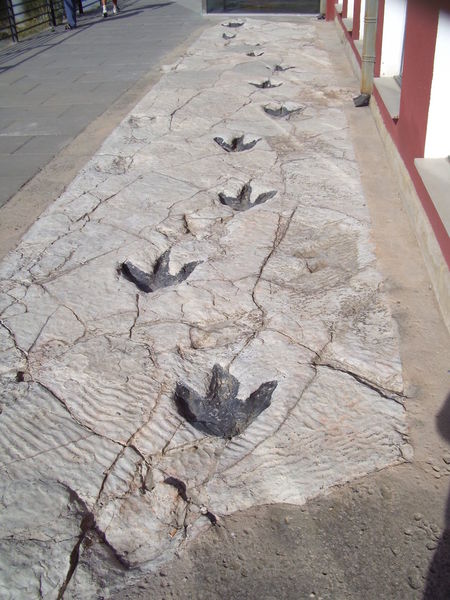Building and Measuring Keyword Footprints

Well it is Search Engine Strategies (SES) in London this week, so I thought I had better be writing something about search engine optimisation. This year’s SES has been taken over by web analytics guys (or so it would seem from the home page). I’m a bit surprised that is has taken this long to get so many Analytics guys there, because analytics should be the basics of your SEO efforts. So today I thought that I’d blog about something that I have been wittering on about at work for ages (although without actually getting any where with). That is we’re going to talk about keyword footprints.
Do you know what they say about the size of a dino’s footprint?
What is a keyword footprint?
A keyword footprint is a series of keywords that you want to make sure that your site is optimised for. These should be a series of phrases that users will type into search engines, which you are likely to be able to rank for (given some work – see below) and that will provide value to your website (whatever that may be).
Really what we are looking for here are a bunch of keywords that you’d really like to (or already do) rank for that give you lots of money through sales (or whatever your other conversion points are). High volume and high value should be the things that you think about.
My recommendation on the size of the footprint is that it should be as big as you think you are able to cope with. As soon as you make it so large you are not actively doing anything with some of the keywords it suggests that you should rationalise it to something more manageable.
How do you build your keyword footprint?
My recommendation for this is to draw on as many sources as you possibly can:
- Use your own keywords that currently drive traffic to your site. You’re probably already monitoring these anyway, so it should be something that you can easily pick up out of your web analytics tool
- Use the keywords that users type into your internal search engine. These are usually not quite the same as those that they type into Google to get to you, so they’ll give some variations on the theme
- Use the titles of the most visited content on your site. If you are a typical content site then this should be relatively easy to pull from your Analytics tool (although you may need to do some mapping if your titles and urls don’t match each other)
- Use Hitwise to find out what your competitors are doing. Find out who your competitors are (either through Hitwise as I’ve discussed) and then turn them into a custom category (either including or not including your own site, depending on how large it is).
I reckon if you did this you could come up with about 100 phrases for each of the four groups listed above. That is going to create a very large list, but you are going to have a lot of cross over. My recommendation is to file that list down to what are going to be a manageable group of search terms. My recommendation is to do this in a group by inspection (rather than running through a tool). It will allow you to notice duplication of terms and allow you to work out where you are likely to have misinterpretations (eg “Sole Trader” always amuses me slightly). Then work out what the volume of searches for each of those search terms is.
You can do this in a number of ways. Firstly you could use Hitwise’s search tools to find out which are the high volume terms. This is useful because it will allow you to see all the subsidiaries of that term and group them together. The next option is to use Google’s own tools in this process. You can look in Google Trends for keywords to see how often they have been searched for and how they compare to other keywords.
What do you do with your keyword footprint?
You optimise the hell out of it. Seriously. What do you mean you don’t know what that means? Well let’s go back to the basics. You have to optimise your site technically first. Go read this post on technical search engine optimisation. You know I said that you should you should have a title, meta description and meta keywords (although these are of less value)? Well suddenly you’ve just created a load of keywords that you can put into those fields. Makes it suddenly seem very simple doesn’t it?
- Put your keywords in your headers: Title tags, meta description, etc
- Put your keywords in your content: If there already – make sure they are titles, make sure they are bold, make sure they are used in context
- Create content that links to those pages with those keywords in the anchor text
Then there is the none technical stuff. This is the hard bit. This is the bit where you have to ask other people for links. But fortunately you are a step ahead, because you created a custom category earlier on in Hitwise, you should be able to find those sites much more effectively.
- Use Hitwise to find out which sites are driving traffic for your search terms and ask them for links
- Use Google/Yahoo!/Bing/Whichever other search engine to find out which sites appear top for your search terms and ask them for links
This process is hard. People don’t want to give you links. Sometimes you might have to find ways of getting them to give you links that may be unusual (“I’ll give you one if you give me one”). Sometimes they just won’t do it. If your content is good though, then people will be more likely to want to link to you.
The next step is to get on out there and start commenting on blogs. Funnily enough blogs are written by the same groups of people who own websites. It’s true. The more you can get into the blogging community the better it can be. I like using Technorati and Google blogs to find blogs that are on a particular subject and then I read them. If they have anything that my content will enhance, I will leave a comment on their blog telling them so. Usually I’ll be explicit (“Disclaimer: I write www.whencanistop.com, so this may be a bit biased, but I’ve written a post on so and so and thought that it added weight to your argument”). These links probably won’t add value directly, but they should give the writer of the blog more of a sighting of your blog and then they are more likely to link to it next time.
Create new content around those keywords. This is something that I cannot stress enough. If you don’t have content relating to those keywords then either drop them or create some content. Build it into your content creation plan. Tell your writers/editors to put them as frequently as possible into their content. Make sure you have the best content so that if someone searched for your terms they would be glad that they found you. This is all user centric – there is no point shoe horning terms into places that the user won’t get value out of.
Measure the effect of your keyword footprint
Even if you are a genius your initial list is going to only be average at best. What you need to do is a continuous process of measuring the effect of your optimisation and then updating your footprint accordingly. I’ve mentioned how you should measure your SEO before, and I see no reason to stop doing this. However for your keyword footprint I would go a couple of steps further:
- Measure your position in the search engine results page (SERPs) over time for your keywords. You can’t do this manually, it could take forever so I suggest using an automated tool
- Measure your conversions from your keyword footprint. If I tell you only one thing today – this would be it. You need to show that you are adding value through the work that you are doing. Measuring the money that you are making (or the additional conversions) will show that this has had the desired effect.
Some of your keywords that you have chosen for your keyword footprint will not convert well. Don’t forget that optimising for search means that you need to optimise your landing pages for conversion too. If the keyword doesn’t perform well in terms of conversion you can think about how you can alter the landing page to improve this. Don’t forget that you could do this through creating custom reports in whichever tool it is that you so happen to use.
If you think that you are spending a lot of time optimising for a phrase but aren’t getting any incremental increases in conversion, then it may be time to drop that keyword from the list and start with others instead. Remember though, you don’t want to un-optimise for those keywords, you just want to move your effort elsewhere. This may mean that you move to a sub category of your key phrase (eg instead of having “Car Insurance” you move to “cheap car insurance”), or it may mean that you move on to something completely different from your earlier list.
So in summary – your keyword footprints are a short list of keywords you specifically want to optimise for. They are the keywords that are going to provide you with the most value over time (not just volume). And the amount of effort you put in should be less than the increase in value you get out (otherwise you wouldn’t have an ROI).



Leave a Reply